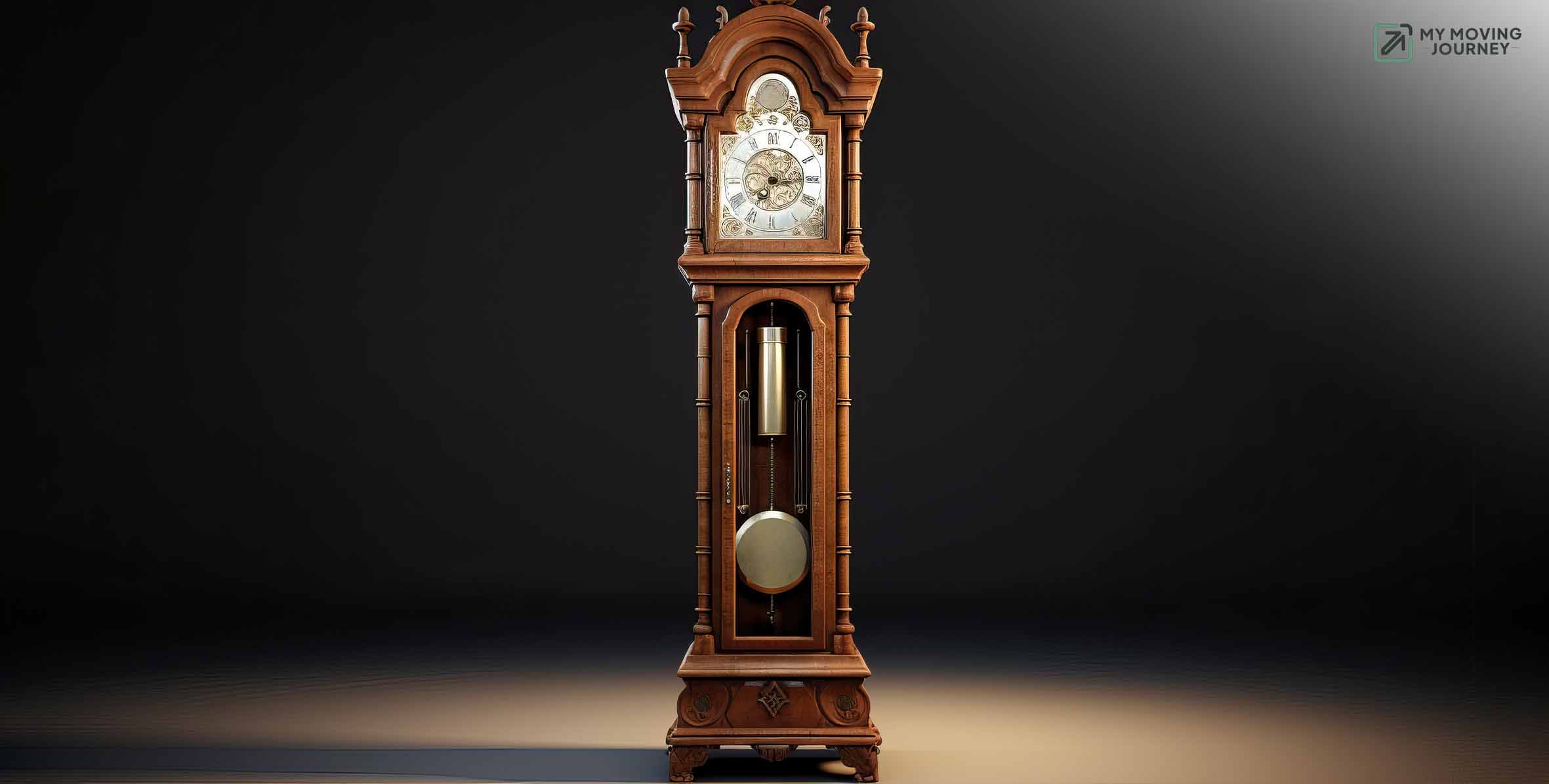Time is the most valuable thing a man can spend.
When it comes to moving a grandfather clock, the sentiment behind this quote couldn’t be more fitting.
Grandfather clocks are often passed down through generations.
They are not just timepieces; they’re heirlooms.
These clocks can stand between 6 to 8 feet tall and weigh up to 200 pounds.
They are delicate and complex, which makes their safe transportation a challenge.
If you think moving a grandfather clock is as simple as lifting and loading, think again.
Statistics show that improper handling of antique clocks results in damage in over 30% of cases.
These damages only occur when people attempt to move them without professional help.
The cost of repairing or restoring a damaged clock can easily exceed $1,000.
Furthermore, these clocks have complex mechanisms, fragile glass panels, and antique woodwork that make them more vulnerable during a move.
Here’s the thing: It is important to understand how to move a grandfather clock.
If you are planning to move on, this blog will give you all the information you need to do it right.
Why Proper Handling Matters
Grandfather clocks are typically 6 to 8 feet tall and can weigh up to 200 pounds or more.
These elegant clocks consist of various fragile components, such as the pendulum, weights, chimes, and glass panels.
If you mishandle any of these parts, it can lead to extreme damage.
That’s why it is essential to making it essential to follow precise steps for safely moving a grandfather clock.
Materials and Equipment Required to Move a Grandfather Clock
Moving a grandfather clock requires specific tools and materials for its safety and to prevent damage.
Moving Blankets & Bubble Wrap
It is essential for protecting the clock’s wooden body and glass panels.
These materials cushion and absorb shocks, which reduces the damage risk by up to 70%.
Dolly with Straps
A dolly provides stability when moving these heavy clocks (100-200 lbs).
Its straps secure the clock and prevent it from tipping during transport.
Packing Tape & Twist Ties
Packing tape holds protective wrapping in place. Twist ties secure chains to avoid tangling when weights are removed.
Sturdy Boxes or Crates
Boxes for smaller parts and custom crates for the clock itself offer maximum protection.
Gloves & Basic Tools
Gloves protect the clock’s finish, while a screwdriver and wrench are needed for disassembling key components safely.
How to Disassemble a Grandfather Clock for Moving
Disassembling is the first step before you even think about lifting the clock.
Here’s how to disassemble a grandfather clock for moving:
Stop the Pendulum
Gently stop the pendulum from swinging. This stabilizes the clock and prevents damage to the pendulum.
Remove the Weights
Most grandfather clocks have three weights: left, center, and right.
These weights must be carefully removed and labeled according to their position to avoid confusion during reassembly.
For added safety, wrap each weight in bubble wrap to prevent damage and place them in a box labeled “Fragile.”
Detach the Pendulum
Open the side panel and locate the pendulum guide.
Carefully unhook the pendulum from its guide and wrap it in bubble wrap.
Secure the Chimes and Cables/Chains
If your clock has chimes, secure them with bubble wrap or foam pieces to prevent damage from vibration during the move.
For chain-driven clocks, use twist ties or packing tape to bind the chains together.
Remove the Glass Panels
Carefully remove any glass panels or decorative elements from the clock's exterior.
Wrap them in padding and bubble wrap to protect them during the move.
Pack a Grandfather Clock
Once you have disassembled the clock, it’s time to pack it.
Packing a grandfather clock properly is integral for its safety.
Wrap the Clock Body
Wrap the clock's main body in moving blankets.
This soft padding acts as a cushion, which protects the clock's finish and absorbs any shocks during movement.
Protect Delicate Parts
Use bubble wrap for the smaller parts, like the pendulum and weights. Place them inside moving boxes.
Use a Sturdy Dolly
Use a dolly as it makes the process easier and also reduces the risk of injury and damage.
Strap the clock securely to the dolly before moving.
How to Protect Grandfather Clock During a Move
To transport the grandfather clock safely requires attention to detail and careful handling:
Keep the Clock Upright
Always move the clock in an upright position to prevent damage to its internal mechanisms.
Use a Moving Truck with Tie-Downs
If you are using a rental truck, always check that the clock is placed against a secure wall and that straps are used to stabilize it.
Drive Cautiously
Slow down at turns and avoid sudden stops. The less jostling the clock experiences, the better its condition upon arrival.
Special Considerations for Antique Grandfather Clocks
Antique grandfather clocks require extra care due to their fragility.
If you own a valuable or older model, hire professionals who specialize in moving large antique clocks.
The cost might be higher, but it’s an investment to preserve a piece of history.
High-value clocks need custom-built crates for maximum protection.
These crates offer additional padding and stability, which is essential when moving delicate antiques.
Reassemble the Grandfather Clock
Once you have reached your destination, it’s time to reassemble the clock.
Follow these steps carefully to reassemble it correctly:
Unpack and Inspect Each Part
Before reassembly, check each component for damage.
If any parts appear bent or damaged, consult a professional clockmaker before proceeding.
Reattach the Pendulum and Weights
Attach the pendulum first, and make sure it hooks securely onto the guide.
Then, add the weights, and always check they are positioned correctly.
Calibrate and Test the Clock
Once reassembled, set the time and test the chimes and pendulum.
It may take a few adjustments to get the clock running accurately again.
How Much Does It Cost To Move a Grandfather Clock
When you move your grandfather clock, it’s not just about the physical transportation; you are also paying for expertise, protection, and care.
Let’s break down all the costs so you know exactly what to expect.
| Service/Material | Description | Estimated Cost |
|---|---|---|
| Local Moving Service | Hourly rates for local moves, usually 2-4 hours required. | $200 - $500 |
| Long-Distance Moving Service | Costs depend on distance; longer moves are more expensive. | $800 - $1,200 |
| Specialty Movers (Antique/Delicate) | Expertise in handling and protecting antique clocks. | $400 - $1,000 |
| Packing Materials | Includes bubble wrap, blankets, boxes, and packing tape. | $50 - $150 |
| Equipment Rental (Dolly, Straps) | Essential for moving large, heavy clocks safely. | $50 - $100 |
| Moving Insurance | Coverage for damage or loss during the move. | $50 - $150 |
| Professional Crating | Custom crates for high-value antique clocks. | $150 - $500 |
Example Scenarios
Let’s take a look at a few scenarios to give you a clearer picture:
Local Move Using Professional Movers
Cost Breakdown:
Moving service (3 hours): $300
Packing materials: $75
Dolly and straps: $60
Insurance: $100
Total Cost: Approximately $535
Long-Distance Move (Out of State)
Cost Breakdown:
Specialty moving service: $1,000
Packing materials: $100
Crating service: $200
Insurance: $150
Total Cost: Approximately $1,450
DIY Move (Local)
Cost Breakdown:
Packing materials: $75
Dolly rental: $50
Insurance (optional): $75
Total Cost: Approximately $200
Additional Tips to Save on Costs
Compare Quotes: Always get multiple quotes from different moving companies, especially if you are considering long-distance services.
Use Your Own Packing Materials: If you have old blankets or bubble wrap, using these can reduce your packing material costs.
Consider Moving Insurance: If your clock is particularly valuable, don’t skip on insurance.
Factors Affecting the Moving Cost
There are some factors that can fluctuate the moving cost, such as:
Distance of the Move
If you’re moving within the same city, you can expect costs to range from $200 to $500.
If you are moving across states or long distances, prices increase significantly.
Moving a grandfather clock from New York to Florida, for example, could cost between $800 to $1,200
Weight and Size of the Clock
Movers often charge based on weight and size. The larger and heavier clocks will cost more to move.
Hiring Professional Movers
Hiring professional movers with expertise in moving large antique clocks can surely give you peace of mind, but it will also cost you more.
Packing Materials and Equipment
If you’re packing it yourself, expect to spend between $50 and $150 on materials alone. And if you are renting equipment like dollies or crates, you can add another $50 to $100.
Insurance
Insurance costs typically range from $50 to $150, which depends on the value of your clock.
Professional Crating Services
For high-value or antique clocks, custom crates may cost between $150 and $500.




